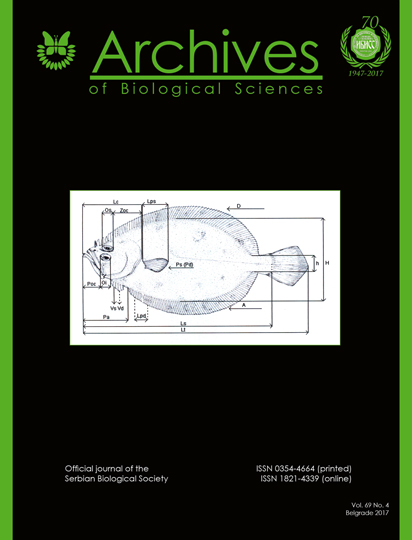Reduced cell proliferation and promotion of apoptosis by Leu5AMD in osteosarcoma cells
Keywords:
Osteosarcoma, chemotherapy, Leu5AMD, apoptosis, cancerAbstract
Leu5AMD is an actinomycin D (AMD) analog obtained by replacing both N-methylvalines present in AMD with N-methylleucines. The potential of Leu5AMD for the treatment of osteosarcoma cells and its mechanism of action are not clearly understood. In this study, we examined the potential use of Leu5AMD in halting the proliferation of the human osteosarcoma cell line Saos-2. Saos-2 cells were treated with different concentrations of Leu5AMD, and proliferation, cell viability, apoptosis and the cell cycle were examined. Among the various concentrations used, 1.2 μM and 6 μM Leu5AMD exhibited a significant effect on Saos-2 cells compared with untreated cells. The proliferation assay and Hoechst staining indicated that Leu5AMD treatment of Saos-2 human osteosarcoma cells resulted in a significant reduction in cell proliferation and enhanced apoptosis. Western blot analysis revealed that Leu5AMD-treated cells had significantly reduced cyclin expression compared with the control. Leu5AMD is responsible for inducing cell cycle arrest and apoptosis. These results support the development of a new drug for the treatment of osteosarcoma.
https://doi.org/10.2298/ABS160712001W
Received: July 12, 2016; Revised: December 2, 2016; Accepted: December 2, 2016; Published online: August 9, 2017
How to cite this article: Wu X, Zhou Z. Reduced cell proliferation and promotion of apoptosis by Leu5AMD in osteosarcoma cells. Arch Biol Sci. 2017;69(4):577-83.
Downloads
References
Himelstein BP. Osteosarcoma and other bone cancers. Curr Opin Oncol. 1998;10:326-33.
Link MP, Goorin AM, Miser AW, Green AA, Pratt CB, Belasco JB, Pritchard J, Malpas JS, Baker AR, Kirkpatrick JA, Ayala AG, Shuster JJ, Abelson HT, Simone JV, Vietti TJ. The effect of adjuvant chemotherapy on relapse-free survival in patients with osteosarcoma of the extremity. N Engl J Med. 1986;19:1600-6.
Bruland OS, Hoifodt H, Saeter G, Smeland S, and Fodstad O. Hematogenous micrometastases in osteosarcoma patients. Clin Cancer Res 2005;11:4666-73.
Lowe SW and Lin AW. Apoptosis in cancer. Carcinogenesis. 2000;21:485-95.
Ding HF and Fisher DE. Induction of apoptosis in cancer: new therapeutic opportunities. Ann Med. 2002;34:451-69.
Johnstone RW, Ruefli AA, and Lowe SW. Apoptosis: a link between cancer genetics and chemotherapy. Cell. 2002;108:153-64.
Stenner-Liewen F, Reed JC. Apoptosis and cancer: basic mechanisms and therapeutic opportunities in the postgenomic era. Cancer Res. 2003;63:263-8.
Waxman DJ and Schwartz PS. Harnessing apoptosis for improved anticancer gene therapy. Cancer Res. 2003;63:8563-72.
Waring MJ. DNA modification and cancer. Annu Rev Biochem. 1981;50:159-92.
Goldberg IH, Beerman TA, Poon R. Antibiotics: nucleic acids as targets in chemotherapy. In: Becker FF, editor. Cancer: A Comprehensive Treatise. New York: Plenum Publishing Corp;1977. p. 427-56.
Farber S. Chemotherapy in the treatment of leukemia and Wilms’ tumor. JAMA. 1966;198:826-36.
Lewis JL. Chemotherapy of gestational choriocarcinoma. Cancer. 1972;30:1517-30.
Wadkins RM, Jares-Erijman EA, Klement R, Rudiger A, Jovin TM. Actinomycin D binding to single-stranded DNA: sequence specificity and hemi-intercalation model from fluorescence and 1H NMR spectroscopy. J Mol Biol. 1996;262:53-68.
Schink JC, Singh DK, Rademaker AW, Miller DS, Lurain JR. Etoposide, methotrexate, actinomycin D, cyclophosphamide, and vincristine for the treatment of metastatic, high-risk gestational trophoblastic disease. Obstet Gynecol. 1992;80:817-20.
Marina N, Fontanesi J, Kun L, Rao B, Jenkins JJ, Thompson EI, Etcubanas E. Treatment of childhood germ cell tumors. Review of the St. Jude experience from 1979 to 1988. Cancer. 1992;70:2568-75.
Nakamura E, Kaneko Y, Takenawa J, Sasaki M. Comparative study of risk criteria for germ cell tumor. Acta Urol Jpn. 1992;38:913-8.
Newlands ES, Bagshawe KD, Begent RHJ, Rustin GJS, Holden LBR. Results with the EMA/CO (etoposide, methotrexate, actinomycin-D, cyclophosphamide, vincristine) regimen in high-risk gestational trophoblastic tumors, 1979 to 1989. Br J Obstet Gynaecol. 1991;98:550-7.
Mauger AB. In: Wilman EV, editor. The chemistry of antitumor agents. Glasgow: Blackie & Son;1990. p. 403-9.
Mauger AB. The actinomycins. In: Sammes PG, editor. Topics in antibiotic chemistry. Chichester: Ellis Horwood;1980. p. 224-306.
Meienhofer J, Atherton E. In: Perlman D, editor. Structure activity relationships amongst the semisynthetic antibiotics. New York: Academic Press;1977. p. 427-529.
Katz E, Lloyd HA, Mauger AB. Enzymatic synthesis of actinomycin D and analogues containing N-methylalanine from synthetic pentapeptide lactone precursors. J Antibiot (Tokyo). 1990;43:731-3.
Mauger AB, Stuart OA, Ferretti JA, Silverton JV. Conformation and dimerization of actinomycin-related peptide lactones in solution and in the solid state. J Am Chem Soc. 1985;107:7154-63.
Mauger AB, Stuart OA. Synthesis and properties of some peptide analogues of actinomycin D. J Am Chem Soc. 1991;34:1297-301.
Schmid I, Uittenbogaart CH, Giorgi JV. Sensitive method for measuring apoptosis and cell surface phenotype in human thymocytes by flow cytometry. Cytometry. 1994;15:12-20.
Vichai V, Kirtikara K. Sulforhodamine B colorimetric assay for cytotoxicity screening. Nat Protoc. 2006;1:1112-6.
Harris AL. Hypoxia – a key regulatory factor in tumour growth. Nat Rev Cancer. 2002;2:38-47.
Hanahan D, Weinberg RA. Hallmarks of cancer: the next generation. Cell. 2011;144:646-74.
Akiyama T, Dass CR, Choong PF. Novel therapeutic strategy for osteosarcoma targeting osteoclast differentiation, bone-resorbing activity, and apoptosis pathway. Mol Cancer Ther. 2008;7:3461-9.
Osaki M, Takeshita F, Sugimoto Y, Kosaka N, Yamamoto Y, Yoshioka Y, Kobayashi E, Yamada T, Kawai A, Inoue T, Ito H, Oshimura M, Ochiya T. MicroRNA-143 regulates human osteosarcoma metastasis by regulating matrix metalloprotease-13 expression. Mol Ther. 2011;19:1123-30.
Kleeff J, Kornmann M, Sawhney H, Korc M. Actinomycin D induces apoptosis and inhibits growth of pancreatic cancer cells. Int J Cancer. 2000;86:399-407.
Bock J, Szabo I, Jekle A, Gulbins E. Actinomycin D-induced apoptosis involves the potassium channel Kv1.3. Biochem Biophys Res Commun. 2002;295:526-31.
Downloads
Published
How to Cite
Issue
Section
License
Authors grant the journal right of first publication with the work simultaneously licensed under a Creative Commons Attribution 4.0 International License that allows others to share the work with an acknowledgment of the work’s authorship and initial publication in this journal.




